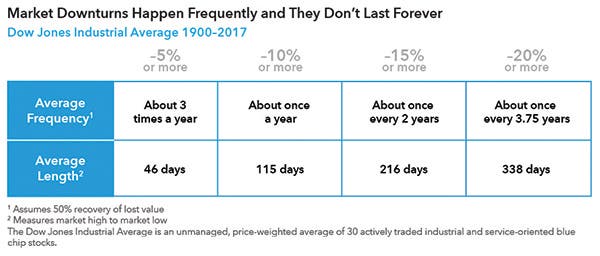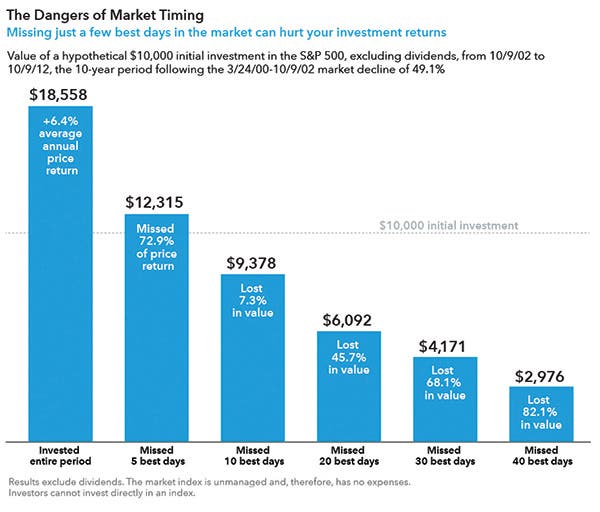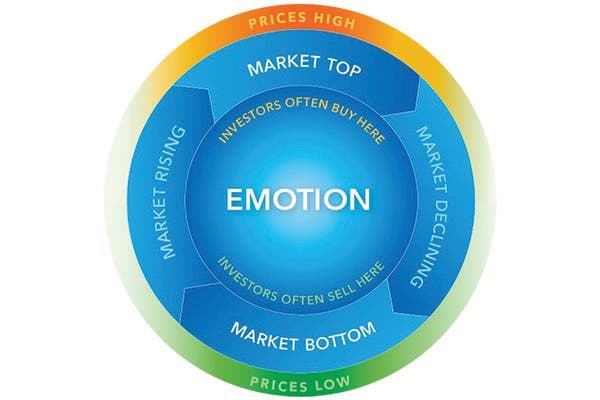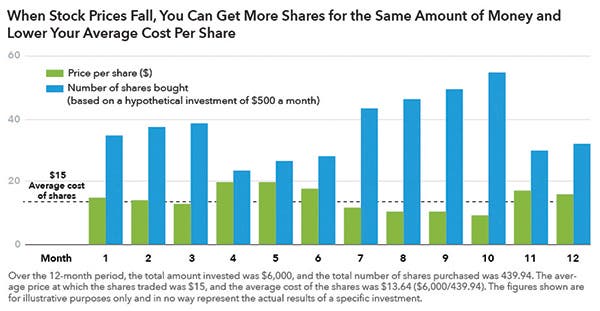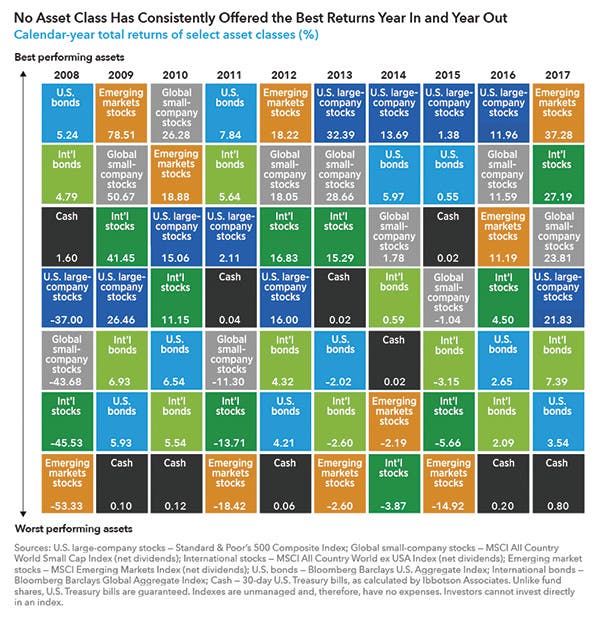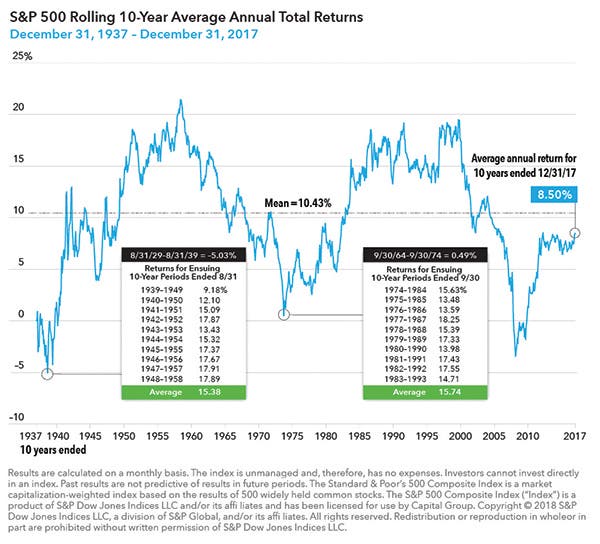You wouldn’t be human if you didn’t fear loss.
Nobel Prize-winning psychologist Daniel Kahneman demonstrated this with his loss-aversion theory, showing that people feel the pain of losing money more than they enjoy gains. As such, investors’ natural instinct is to flee the market when it starts to plummet, just as greed prompts us to jump back in when stocks are skyrocketing. Both can have negative impacts.
But smart investing can overcome the power of emotion by focusing on relevant research, solid data and proven strategies. Here are six principles that can help fight the urge to make emotional decisions in times of market turmoil.
1. MARKET DECLINES ARE PART OF INVESTING.
Stocks have risen steadily for nearly a decade. But history tells us that stock market declines are an inevitable part of investing. The good news is that corrections (defined as a 10% or more decline), bear markets (an extended 20% or more decline) and other challenging patches haven’t lasted forever.
Source: Capital Group
The Dow Jones Industrial Average has typically dipped at least 10% about once a year, and 20% or more about every 3.75 years, according to data from 1900 to 2017. While past results are not predictive of future results, each downturn has been followed by a recovery and a new market high.
2. TIME IN THE MARKET MATTERS, NOT MARKET TIMING.
No one can accurately predict short-term market moves, and investors who sit on the sidelines risk losing out on periods of meaningful price appreciation that follow market downturns.
Every Standard & Poor’s 500 Index decline of 15% or more, from 1929 through 2017, has been followed by a recovery. The average return in the first year after each of these market declines was nearly 55%.
Even missing out on just a few trading days can take a toll. A hypothetical investment of $10,000 in the S&P 500 made in 2002 – the start of the recovery following the bursting of the technology bubble – would have grown to more than $18,000 by the end of 2012. But if an investor missed the 10 best trading days during that period, he or she would have ended up with just $9,378 – less than the initial investment.
Source: Capital Group
3. EMOTIONAL INVESTING CAN BE HAZARDOUS.
Daniel Kahneman won his Nobel Prize in 2002 for his work in behavioral economics, a field that investigates how individuals make financial decisions. A key finding of behavioral economists is that people often act irrationally when making such choices.
Emotional reactions to market events are perfectly normal. Investors should expect to feel nervous when markets decline. But it’s the actions taken during such periods that can mean the difference between investment success and shortfall.
Source: Capital Group
One way to encourage rational investment decision-making is to understand the fundamentals of behavioral economics. Understanding behaviors like anchoring, confirmation bias and availability bias may help investors identify potential mistakes before they make them.
4. MAKE A PLAN AND STICK TO IT.
Creating and adhering to a thoughtfully constructed Financial Plan is another way to avoid making short-sighted investment decisions — particularly when markets move lower. The plan should take into account a number of factors, including risk tolerance and short- and long-term goals.
One way to avoid futile attempts to time the market is with dollar cost averaging, where a fixed amount of money is invested at regular intervals, regardless of market ups and downs. This approach creates a strategy in which more shares are purchased at lower prices and fewer shares are purchased at higher prices. Over time investors pay less, on average, per share. Regular investing does not ensure a profit or protect against loss.
Investors should consider their willingness to keep investing when share prices are declining. We encourage our clients to meet with the BWFA team twice a year to review their financial plan and not to focus on stock market volatility.
Source: Capital Group
Retirement plans, to which investors make automatic contributions with every paycheck are a prime example of dollar cost averaging.
5. DIVERSIFICATION MATTERS.
A diversified portfolio doesn’t guarantee profits or provide assurances that investments won’t decline in value, but it does lower risk. By spreading investments across a variety of asset classes, investors lower the probability of volatility in their portfolios. Overall returns won’t reach the highest highs of any single investment – but they won’t hit the lowest lows either.
For investors who want to avoid some of the stress of down markets, diversification can help lower volatility.
Source: Capital Group
6. THE MARKET TENDS TO REWARD LONG-TERM INVESTORS.
Is it reasonable to expect 30% returns every year? Of course not. And if stocks have moved lower in recent weeks, you shouldn’t expect that to be the start of a long-term trend, either. Behavioral economics tells us recent events carry an outsized influence on our perceptions and decisions.
When stocks are falling, it’s important to maintain a long-term perspective. Although stocks rise and fall in the short term, they’ve tended to reward investors over longer periods of time. Even including downturns, the S&P 500’s mean return over all 10-year periods from 1937 to 2014 was 10.43%.
It’s natural for emotions to bubble up during periods of market volatility. Those investors who can turn off the news are better positioned. At BWFA we encourage you to make an appointment to review your financial goals. We are here to help and assist with our entire team of professionals.
Source: Capital Group
Robert G. Carpenter | President & CEO | rcarpenter@bwfa.com




